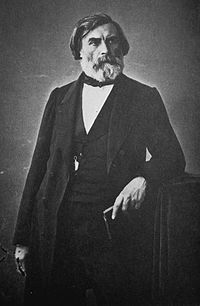Auguste Ottin


Auguste-Louis-Marie Jenks Ottin (1811–1890) was a French academic sculptor and recipient of the decoration of the Legion of Honor.
Early life
Ottin was born and died in Paris, where he was a pupil of
Exhibitions

Ottin was responsible for the assembly in 1834 of the vast
His portrait bust of the painter and Director of the Academy,
Ottin exhibited in 1841 a bust in marble, and afterward produced a group of "Hercules Presenting to Eurysthea the Apples of Hesperides," in marble; busts of Chaptal, Quesnault, Ingres, (1842); and Ecce Homo, in marble, (1844).[1] His 1846 "Indian Hunter Surprised by a Boa" in bronze resulted in the awarding of a medal and was a featured piece under the center dome of the New York Crystal Palace in 1853,[4] and was later mounted at Fontainebleau Chateau outside Paris.
His Travail manuel is at the
About the same time he was commissioned to provide the sculptural elements for a room in an old palazzo in Florence, via de’ Renai, that was designed as an homage to the social utopian Charles Fourier by an admirer of his philosophy, François Sabatier-Unger, who had recently wed the palazzo's owner, the Austrian singer, Caroline Unger.
During the Second Empire, he executed a full-length official sculpture of
In the new Square Emile-Chautemps at Le Sentier, Paris IIIème, among the sculptural figures enhancing two oval pools under the general artistic direction of Gabriel Davioud, Ottin was entrusted with seated bronze figures of Mercury and Music.[5]
In the extensive sculptural programme of the Palais Garnier for the Opera, Ottin was entrusted with La Musique and La Danse seated figures leaning on a central medallion in the arched pediment on the west-facing facade. He also provided standing females representing northern French cities for the less-demanding programme of the Gare du Nord[6] Among similar commissions are his statues of Euthymenes and Pytheas for the Bourse, Marseille.[7]
References
- ^ a b Obituary, "August Louis Marie Ottin," New York Times, January 11, 1891
- ^ Christie's New York, Eduardo Guinle collection, 2003; Walters Collection, Baltimore Archived August 24, 2005, at the Wayback Machine
- ^ Achenbach Foundation for Graphic Arts purchase 1987.2.32.
- ^ Art and Industry: As Represented in the Exhibition at the Crystal Palace; Greeley, Horace; Redfield; (New York, 1853); p. 59
- ^ Mercure and La Musique Archived May 11, 2006, at the Wayback Machine.
- ^ Gare du Nord Archived May 11, 2006, at the Wayback Machine.
- ^ Euthymenes and Pytheas
Further reading
- Emmanuel Schwartz, Les Sculptures de l'École des Beaux-Arts de Paris. Histoire, doctrines, catalogue, École nationale supérieure des Beaux-Arts, Paris, 2003.
- François-Xavier Amprimoz, (Anna Nenci and Jean Diële, translators), Un ciclo decorativo fourierista nella sede del Consiglio Notarile di Firenze (First published as "Un décor ‘fourieriste’ à Florence", Revue de l’Art 48 (1980)
- Polyphemus Surprising Acis and Galatea in its setting Archived 2011-07-19 at the Wayback Machine, and a detail
External links
![]() Media related to Auguste Ottin at Wikimedia Commons
Media related to Auguste Ottin at Wikimedia Commons
